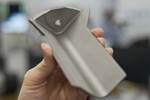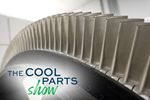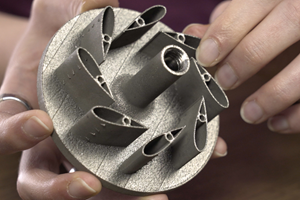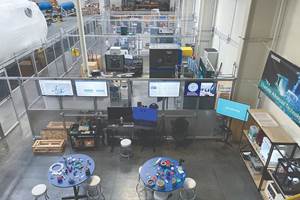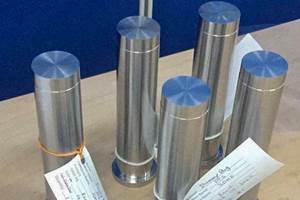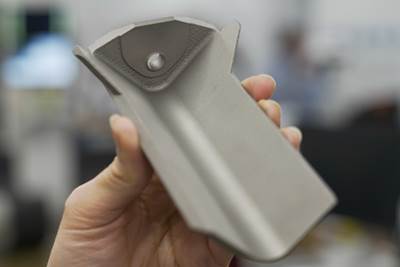
Then-Siemens Energy applications engineer SJ Jones holds a part for a combustion system indicative of the kind of larger, complex components the company now 3D prints — both for its own systems and external customers. Photo Credit: Siemens Energy
Deploying additive manufacturing (AM) across a single, one-location business is difficult enough. Assuming that company’s owner, its management, and the employees who will own and touch the process are all on board, it is still a significant challenge to identify the right parts for additive, develop them for the additive process chosen, and successfully implement the technology. Now multiply the challenge across a global energy company, with turbines, technicians, engineers, spare parts and more spread all across the world. How does a company like this even start to bring AM into the fold for its own needs, let alone to serve external customers as well?
This is the scenario that Siemens Energy has been working out, and successfully finding its way through. Facing the hurdles of people and resources widely dispersed across the world, the company’s additive manufacturing development team has nonetheless found a way forward for this technology, both within the company and beyond. The hub of its AM operations in North America, located in Orlando, Florida, encapsulates what it takes to deploy 3D printing effectively to serve internal needs for power generation components as well as external users in adjacent industries, as I got to discover on a recent visit.
Additive Manufacturing and Innovation Co-Located
The Orlando site that serves as Siemens Energy’s main additive manufacturing facility in North America is actually co-located with its Innovation Center, an applications-focused facility staffed by about 50 people and equipped with CNC machining, laser and waterjet cutting, EDM, robotics and other manufacturing capabilities in addition to 3D printing. While the company has been a user of AM for the last decade, much of its current manufacturing proficiency derives from its 2016 acquisition of Materials Solutions, an additive manufacturing business based in the United Kingdom that was previously a Siemens Energy supplier. That move brought AM expertise into the company, but also meant acquiring Material Solutions’ external customers, a business pursuit Siemens Energy decided to keep intact and grow.
When the company decided to transfer the AM capabilities of Materials Solutions into an applications center in North America, where to locate that capability was cause for careful consideration. Options included locating the center near one of the company’s existing manufacturing sites, or near the design engineering hub. But the decision-making process coincided with the creation of the Siemens Energy Innovation Center in Florida, which happens to be just down the road from a major Siemens Energy design hub, and this presented an opportunity. Thus additive manufacturing became part of this innovation facility when it opened in 2019, and the company expects this proximity to design and innovation will prove meaningful for realizing AM’s long-term potential.
The Innovation Center today is equipped to handle rebuild, repair and maintenance work for Siemens Energy turbines and other power generation equipment. 3D printing on this side of the business is applied for rapid prototyping as well as custom tooling and parts needed to respond quickly to problems in the field.
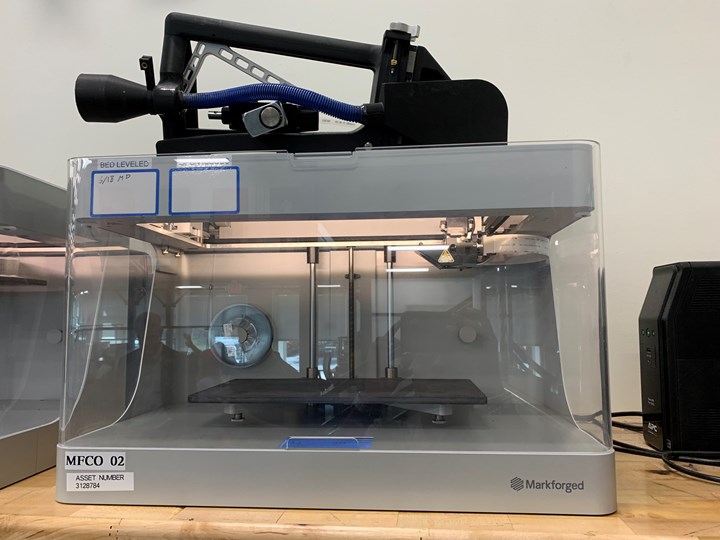
In one example, the center used its Markforged fiber-reinforced polymer 3D printers to create a cut-off tool (shown on top of the printer here) designed to remove a small amount of material from a gas turbine component in the field. The 3D printed tool was produced in about 6 weeks, faster than it could have been produced if the components were made through machining, and at a price low enough to justify this type of one-off solution.
How 3D Printing Will Change Power Generation
Both the additive manufacturing group and Innovation Center serve Siemens Energy as well as answering to external clients. Like the Innovation Center staff, the AM team members often find themselves producing replacement parts and tools for the company's own internal use. But more frequently, this team is implementing serial production of parts on the AM “roadmap” where 3D printing can be used to improve the efficiency, usability or some other aspect of a power generation component. And, it provides additive manufacturing services to customers in adjacent industries such as aerospace and automotive.
“We deal with both ‘push’ and ‘pull’ opportunities for AM,” says Quan Lac, head of additive manufacturing for the Americas. “Push” opportunities are the situations where something unplanned happens and a repair is needed, or where a customer is asking for a specific part that happens to be suitable for 3D printing. While some design modifications or other changes may be possible, these applications come on an as-needed basis and the focus is more on delivering a functional replacement than it is optimizing via AM.
Push opportunities may not be the ideal applications for additive manufacturing, but they can be valuable tools for evangelizing the technology within the Siemens Energy organization nonetheless. When additive can solve a problem quickly or more affordably than conventional techniques, engineers begin to appreciate its capabilities and to look for new opportunities to use it.
“The 3,000 engineers at Siemens Energy don’t need to be AM experts,” Lac says, “but they need to know that we are here.” When additive can step in to meet an urgent need, it’s one more win that helps get the word out.
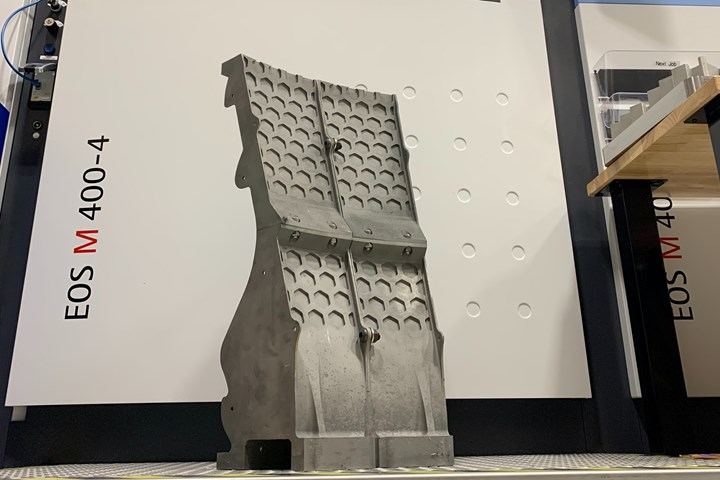
Four of 46 3D printed components that make up a large ring for a generator cover, replacing a bronze casting with a long lead time. Photo Credit: Siemens Energy
Above, one example of a “push” part where unplanned outages can be addressed through the use of 3D printing: These components are part of a generator cover, essentially a 6-foot-diameter O-ring. The original bronze part was procured through casting and could take up to one year to obtain. The AM group was able to redesign and release a 3D printed ring design in pieces (46 pieces to be exact, made four at a time) from nickel alloy, resulting in a 35% lighter assembly that went from design through 3D printing in just 18 weeks. Switching to 3D printing delivers the needed part much faster than it could have been procured conventionally, solving the lead time problem, but the change in material and process also brings in significant cost savings, with the 3D printed version produced for about one-sixth the cost of the original casting.
“Pull” opportunities meanwhile represent a longer-term, less happenstance approach to additive with more opportunities to optimize for the technology. Pull parts are those the group identifies and chooses to pursue intentionally. The AM group routinely “mines” existing Siemens Energy systems for good AM candidates, looking for instances where a switch to additive manufacturing could lead to benefits in lead time, cost and/or performance. With a pull application (like the part pictured below), it is possible to invest in true design for additive manufacturing (DFAM) and optimize the part for manufacturing as well as its end use in a power generation system.
A “Pull” Opportunity for 3D Printing
Siemens Energy identified this component for a combustion system as a good candidate for 3D printing. Redesigning the part to take full advantage of this process provided benefits both in manufacturing and in its performance:
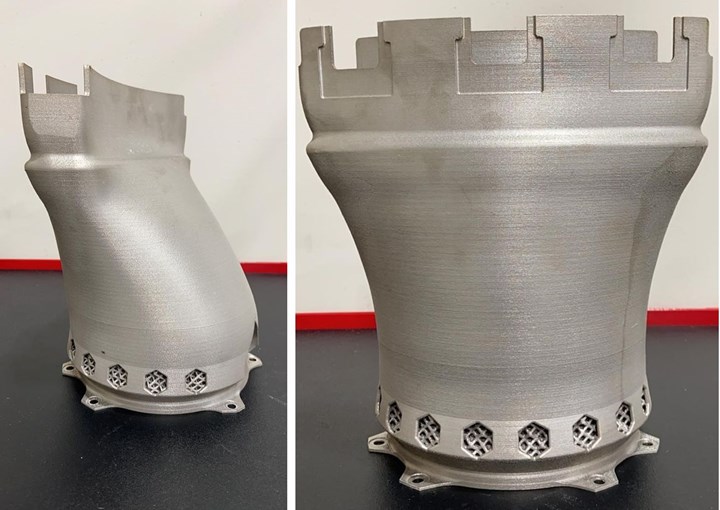
The part was previously made from 2-3 parts welded together. 3D printing it in just one piece eliminated those assembly steps, thus reducing its cost. Photo Credit: Siemens Energy
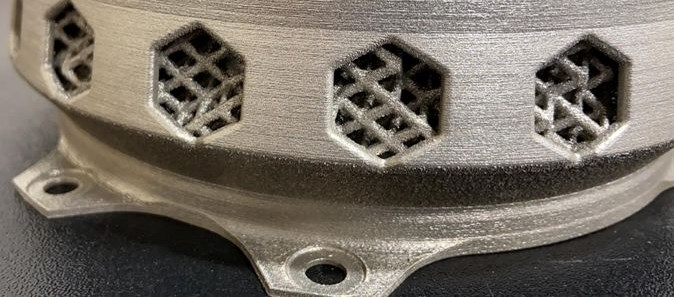
But 3D printing also enabled design changes that improved the performance and durability of the part. In the conventional component, inner and outer walls are separated by a gap. In the printed part, this gap is filled by a lattice. Photo Credit: Siemens Energy
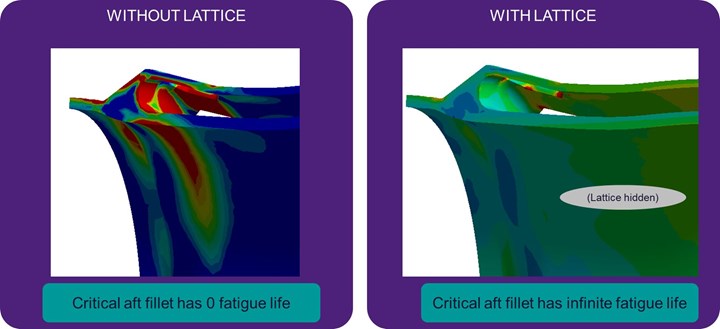
The simulation results shown here illustrate improved fatigue life as a result of the way the lattice redistributes thermal stress between the walls. Image Credit: Siemens Energy
Beyond Energy
The additive manufacturing space at the Innovation Center is equipped with one EOS M290 and one EOS M400-4 for nickel alloys, plus an EOS M400-1 that is dedicated to aluminum. Internal Siemens Energy prototyping and production applications still account for the majority of the additive manufacturing group’s activity today. (Some of that work even comes from another Siemens additive site, CATCH in South Carolina.) However, work for external customers in adjacent industries is growing quickly and helps Siemens Energy to advance its own understanding of AM for power generation applications. Components like gas turbines are optimized for heat transfer and designed for a fatigue life of 30 years and up, while parts for motorsports might be optimized for weight savings with a fatigue life in the hundreds of hours. Even so, lessons learned from one industry application can advance the other.
“We’re attacking the same problem but coming at it from different angles,” says Zach Dyer, technical head of engineering services for AM at Siemens Energy at the time (both Dyer and Jones departed the company just before this article was first published). This gives the additive manufacturing group a potential edge over contract manufacturers that specialize in just one industry. “If we could share material characterization across industries, we could advance AM faster,” Dyer adds. This cross-pollination that doesn’t have a chance to occur between manufacturers serving different spaces can happen at a facility like this, where the work is primarily focused on energy but also crosses into aerospace, automotive, defense and more.
Meet the Customer Where They Are
But regardless of whether the work is a push or pull part, or an internal or external job, the additive manufacturing group has to take care to meet clients where they are, teach them about additive manufacturing, and realistically evaluate each part. Applications engineer SJ Jones (who uses they/them pronouns) is often at the forefront of these initial conversations.
“My job is to get the part from the customer and say yes or no,” Jones says, describing the earliest stage of the process where the part’s viability for metal additive manufacturing must be evaluated. The customer providing the part might be an internal or external one, but the process is the same. If the answer is yes, Jones goes on to create a quote, complete the design work and print the part. But even if the answer is no, that is rarely the end of the conversation. Instead, it frequently becomes the jumping-off point that leads to a real application.
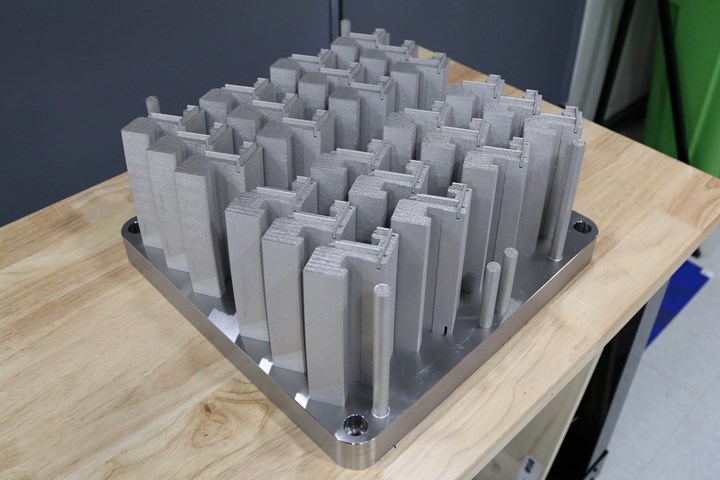
There’s a difference between customer wants and customer needs, Jones says. In this example, an internal Siemens Energy customer asked if the AM team could reproduce the pressurized seals for a set of turbine vane retainers. The team said yes, but why just the seal? Ultimately the entire vane retainer was printed (shown) incorporating those seals and reducing the labor and lead time in production. Photo Credit: Siemens Energy
Sometimes, that discussion leads to design changes that make 3D printing viable for that part. Sometimes, it results in bringing the rest of an assembly into the conversation, and consolidating several parts into one (see above). Sometimes, it ends in Siemens Energy building a totally different part for the customer, because that item proved to be a better fit.
“There’s a lot of education that goes into it,” Dyer says. “Once people see it they get excited, but they don’t know the limits.” Teaching customers what is possible becomes almost as important as letting them know that additive is an option in the first place.
Applications Engineer as Educator
That ability to educate is a valuable skill for any applications engineer, but especially for one working in additive manufacturing. The historic rules of design for manufacturing don’t necessarily apply for AM, which is an opportunity on the production side but can be a challenge in a customer-facing role. Jones keeps a number of sample parts on hand that easily demonstrate some of these principles:

Photo Credit: Siemens Energy
The strength of lattices.
Metal powder bed fusion parts start off anchored to the build plate, and require support structures to both hold up features and to transfer heat during printing. Most supports are based on some sort of lattice to reduce material usage and minimize the anchor points on the part. But lattice supports are still made of the same metal alloy as the part, which means they are difficult to remove even if they may look delicate. As shown to the right, Jones keeps a collection of support structures that have been removed from parts to demonstrate how strong lattices are and emphasize the labor savings from keeping supports to a minimum.
The importance of stress relief.
Because metal AM is a faster route to a near-net shape, customers sometimes have unrealistic timeline expectations. As a way of negotiating a faster delivery, they sometimes suggest skipping heat treat, a postprocessing step that relieves the thermal stresses built up in the part during printing. The stair-step piece pictured on the table above is an example of a part that was printed flat on the build plate and cut off with wire EDM without this step — it has warped significantly as a result, and rocking this part across a table helps demonstrate the risk of “potato chipping” when heat treating is skipped.
The need for postprocessing of critical features.
The sample part below was never intended as a teaching tool but has become the answer to the question Jones frequently encounters: “Can you 3D print a thread?” The answer is yes, “but you can feel how it catches,” they say, twisting the dragon egg open to reveal a chamber inside. “I always recommend that customers have their threads machined.” Just because it is possible to 3D print threads or other features doesn’t mean they will function as required without significant postprocessing, and sometimes machining is the more direct route to meeting that requirement.
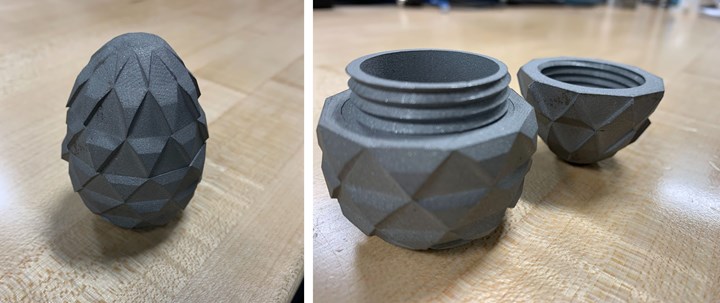
Keys to Additive Implementation
Despite the challenges with additive manufacturing generally, and with educating and selling it to many types of customers specifically, Siemens Energy’s AM group is making an impact on how the company operates. Parts redesigned and made additively are saving time and cost in manufacturing, bringing efficiency benefits to power generation systems, and helping teams work more productively.
Why is Siemens Energy succeeding at implementing additive manufacturing? The willingness to educate customers and work with their needs is one factor, as described above. Another is the AM group’s proximity to Siemens Energy’s Orlando design hub, Lac says. The AM team can pull design expertise easily when needed, from the engineers who understand intricately the demands of the gas turbine. When the AM group identifies a good use case for 3D printing, it can consult the design team for help with lightweighting, topology optimization or other goals to ensure the printed part will serve the intended purpose.
Co-location with the Innovation Center is another boon. Any AM team member has the benefit of consulting with a machinist just down the hallway, opening the door to postprocessing feedback right from the beginning. Plus, the simple fact that the U.S. facility exists is helping to raise the profile of additive manufacturing within Siemens Energy in North America — capability that was perhaps easy to overlook when the expertise and capacity were outside of the U.S.
Ultimately, the success of Siemens Energy’s AM efforts might be explained by communication, both in the sense of interpersonal interactions and in how digital information now travels across sites. The Orlando facility and its machines are so in tune with what is happening at the UK location that it’s common for the two to share files and send work across the pond digitally — distributed manufacturing realized. Additive manufacturing implementation needs both the digital and the analog, the quantitative and the qualitative, and conveying both will be necessary for the technology’s continued adoption.
Related Content
Gas Turbine Swirlers: Co-Optimizing Despite the Complexity
Power generation and additive manufacturing researchers at Penn State University have joined forces to explore what impact the design of a swirler can have on gas turbine performance.
Read MoreAdvancing Additive Manufacturing With a CATCH and Release Approach
Solutions for energy efficiency, sustainability, part repair and more are developing at Siemens’ Charlotte Advanced Technology Collaboration Hub (CATCH) in North Carolina.
Read MoreConocoPhillips Sees Oil and Gas Supply Chain Opportunity With Additive Manufacturing
Production of parts when needed and where needed can respond to the oil and gas sector’s multibillion-dollar challenge of holding parts in inventory. The supply chain benefit will justify additive even before the design freedoms are explored.
Read More3D Printed Reactor Core Makes Solar Fuel Production More Efficient
The solar reactor uses water and CO2 from the air and sunlight as the energy source to produce carbon-neutral liquid fuels, for example, solar kerosene for aviation.
Read MoreRead Next
How to Implement Additive Manufacturing Across a Global Company: 5 Lessons
With more than 100 facilities and about 200,000 employees worldwide, Flex has a steep challenge in bringing 3D printing into its operations. Five things the company is learning.
Read MoreAM Will Change Power Generation, But Needs To Prove Itself First
In gas turbines and in nuclear power, Oak Ridge National Laboratory is working with major manufacturers to validate metal 3D printing for conventional parts as a prelude to developing the unconventional ones.
Read More3D Printed Turbine Blades for More Efficient Power Generation: The Cool Parts Show #35
Blades made through additive manufacturing promise to let turbines run hotter, and therefore generate more power without increasing in size.
Read More

.jpg;width=70;height=70;mode=crop)

